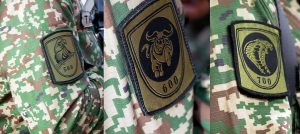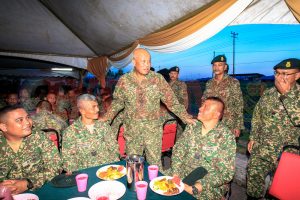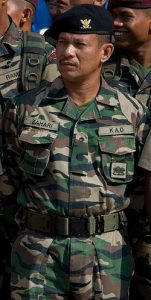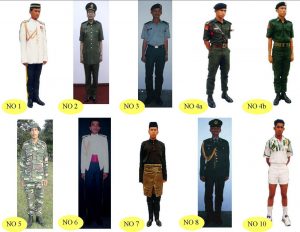SHAH ALAM: Patches Galore. At the Army farewell parade on Dec 9, Jen. Raja Mohamed Affandi Raja Mohamed Nor launched the patches for use on the service’s digital camouflage uniforms. The low -viz patches are produced for the 13 Army formations.
As I was not able to make it to the launch in Port Dickson, posted below are the insignias worn by the soldiers during the new Army chief official address held at the Sg Besi camp today (Jan. 7, 2017). As you might be aware Raja Affandi – who took over as the Chief of Defence Force on Dec. 16 – was succeeded by Jen. Zulkiple Kassim.


The patches above are for the Army’s Headquarters, Western Field Command and the Eastern Field Command respectively. I am not sure whether these new velcro, patches will be worn during parades only and not during operations or training exercises.

In the past, only unit’s patches or tabs were sown to the combat uniform (Uniform No. 5, mostly on the front pockets or shoulder and not the formation they belong too.

The formation patches in high visibility colours are usually worn parade uniform or No. 4 uniform. The graphic below is from Catatan Seri blog, which listed the number and types of the Army’s official attires. The No. 1 is the Ceremonial Uniform, No. 2 Bush Jacket, No. 3 Work Clothes, No 4, Parade Uniform, No 5 Camouflage Uniform, No 6. Mess Kit, No. 7. National Dress, No. 8. Service Uniform and No. 10 PT Dress. No. 9 the Suit, is not listed.

Meanwhile, in his first speech as the Army chief, Zulkiple outlined his vision for the service to continue its excellence service based on five core values. The core values are empowering readiness, strengthening integration, enhancement of professionalism, organisational consolidation and enhancing the quality of life.
— Malaysian Defence.
If you like this post, buy me an espresso. Paypal Payment
View Comments (14)
Is that a gatling on the uro vamtac?
Reply,
Nope, its a Gatling on a Weststar GKM-1
What is the role of a fitted for radio vehicle? Communication or patrol?
Reply
Communication
Nihd,
Any vehicle that has more radios [and aerials] than other vehicles are intended solely for comms. Whilst other vehicles will be on the section and platoon net; dedicated signals vehicles will be tied to battalion and brigade [and even higher levels] net.
I know that 4a and 4b has been stopped but what's no.9 uniform, again?
Reply
No. 9, Lounge Suit. Mostly for official duties.
Horray little patches have been introduced just like the SAF ..but to my personal taste its best for the armed forces go without certain uniforms such as no.2..no.4a n 4b and no.7 uniform...cut cost on these uniform n maybe most of the boys M4 could be attached wit a telescope sight.
Outsource the issuing of uniform in each camp to vendor...thus reducing the armed forces non combatant manpower...just do the sum...the armed forces will just have to provide a store for a vendor to run...instead of having a quartermaster...staffsargent n other ranks in the payroll....the savings is significant if done properly....jst my secepek
"Outsource the issuing of uniform in each camp to vendor…thus reducing the armed forces non combatant manpower…just do the sum…the armed forces will just have to provide a store for a vendor to run…instead of having a quartermaster…staffsargent n other ranks in the payroll….the savings is significant if done properly….jst my secepek"
Singapore does that. The larger camps have "E-marts" that are open every day. The smaller camps have a shop, not as well stocked and the contractor guys open them by rotation once a week. Where there are lots of reservists, you'll see a big one. I wrote a post on their gear credits system a few months ago when we were discussing buying surplus SAF gear.
But they do it to save on uniformed manpower, to avoid pumping out reservists with little useful experience year after year.
I don't think we will save if we do it, and not just because of the parasitic load. Our labour costs are much lower. We have too many camps spread out around the country, it will cost a lot to give even a fraction a well stocked "E-mart" (the Singapore term for the commercial shop). The country is too big for a team to rotate among camps. We have a much lower turnover of soldiers to issue gear.
And you know what? Units already have a quartermaster. I would suggest using the existing system, supplemented by commercial mail shipping if need be.
Agreed but the magic word here is cut cost tuan AM...we introduced something sure.. but we have to remove something be it big or small so that other important military hardware can be bought with the amount save.yes i know the SAF e mart is too advanced by MAF standard...just for example those vendor who supply MAF with all the military barang barang can set up stall within the camp or outside camp...so the armed forces can phase out the quartermaster n its other ranks to be absorb to other useful dept.
Why always the old mentality fine tune n iron out issues....try it out with 1 experimental unit n improve on it...by the way tuan AM how many SAF senior ranking officers have received golden handshake? last time SAF use to be a golden rice bowl for some but not any more the regulars are contracted for 5 yrs the max this is for wat reasons may i ask?
I forgot to mention one important thing. The operator of the e-marts is not a private company, it is ST Logistics which is fully government owned. SAF reduces manpower, the overhead disappears but gets passed back to SAF as variable cost when they issue gear and uniforms through the system. The soldiers also pay when they buy things beyond their annual or biannual credit allocation ($200 annual for combat soldiers, $113 for service troops).
There is nothing advanced about the SAF e-mart system that is beyond us. I only said the circumstances are different. Besides the geographical challenges, we have a lower turnover of soldiers so fewer customers for the shops.
What do you mean by golden handshake? First, they don't separate soldiers involuntarily. It is common for MAINSTREAM soldiers to retire at all ranks. If you can't attain a high rank they let you serve to retirement age and there is no free gratuity at the end.
Retirement age is 45 for officers of rank LTC and below, 55 for warrant officers and officers COL and above. A new rank, Senior LTC, was introduced a few years ago. It is a terminal rank, meaning if you are an LTC selected for COL you will bypass it and go straight to COL. If you are not selected, you will get SLTC and retire at age 45.
Now if you are a scholar, you are on a completely different pay scale and are pegged for fast promotion to senior ranks and after service, senior levels of government. For example, minister Chan Chun Sing was MGen and CoA at age 40. He retired after one year, entered elections and became a minister. The subsequent CoA was himself a former soldier who was in government, and he went back into the army. At that level, they draw Administrative Service (senior civil service) pay and it is golden. This is why you won't see pay above CPT in recruitment brochures.
I guess I should have given a one shot reply.
To add, the SAF manages some inventory stockpiles, such as spare parts and personal equipment, through the Army Logistics Base. It is owned by the SAF and located in a warehouse in an SAF camp. The warehouse is operated by ST Logistics.
The e-marts only handle personal equipment. When you visit Singapore, you can visit the two e-marts open to the public at Chevrons and Safra Mount Faber and even buy items in cash. Which is what soldiers do if they have used up all their credit (the credit is given annually for active soldiers and biennially for reservists).
When a soldier enlists, his clothing and equipment sizes are given to ST Log. ST Log will pack it in a bag that he picks up on his enlistment date.
Like said, all this saves manpower and fixed cost for SAF but the SAF pays back because the price of every item includes an amount that goes to ST Logistics.
The US issues and takes back gear (does not sell) through a different arrangement, it is called the Consolidated Issue Facility (CIF).
AM - ''There is nothing advanced about the SAF e-mart system that is beyond us. I only said the circumstances are different.''
Very true ....... It's more a question of whether their system will work for us; not the system being ''too advanced'' [not sure how Red Sot came to that conclusion]. What works for them doesn't mean it will automatically work for us. For one, there are many more bases here spread out over a larger area. Secondly per annum there is a large intake of NS people entering the system.